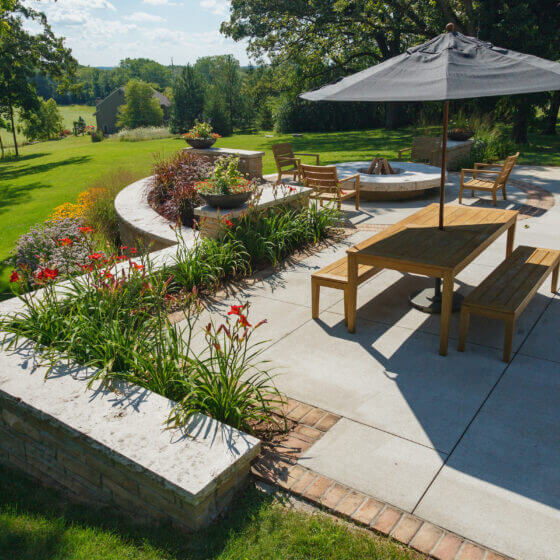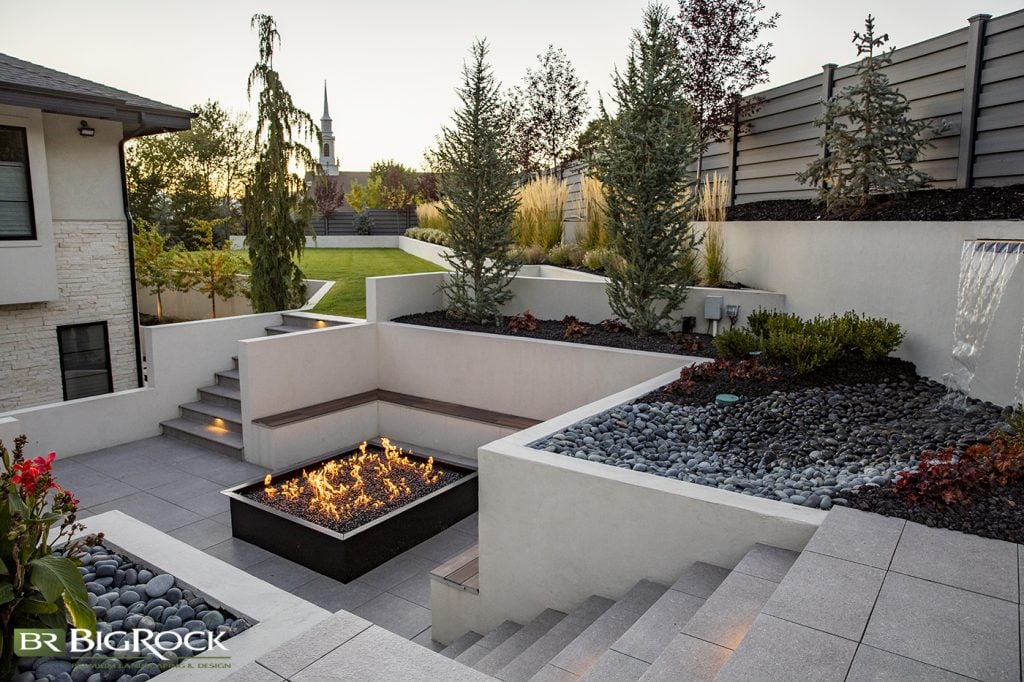Exploring Various Sorts Of Landscaping to Improve Your Outdoor Setting
Landscape design plays an essential duty in specifying outdoor spaces. Numerous designs, from conventional gardens to modern-day minimalist styles, supply distinctive advantages for boosting appearances and function. Incorporating elements like xeriscaping and indigenous plants can contribute to eco-friendly equilibrium. Comprehending the interaction of hardscape and softscape is vital for producing inviting atmospheres. The choices available can be frustrating, motivating one to mirror on which design ideal aligns with their vision for an outdoor haven.
Conventional Garden Landscape Design

While lots of modern yards embrace minimalism and native plantings, conventional yard landscape design stays a valued strategy that emphasizes balance, framework, and ornamental functions. This design often includes official geometric formats, where hedges, paths, and flowerbeds are prepared with precision. Central prime focus, such as water fountains or sculptures, attract the eye and give a feeling of harmony.Traditional landscaping often consists of a selection of plant types, showcasing seasonal blossoms and evergreen aspects. Traditional hedges, perennials, and annuals create lively colors and textures throughout the year. Furthermore, pergolas, trellises, and arches add vertical rate of interest and act as support for climbing plants, boosting the general aesthetic.The usage of all-natural products, such as rock and timber, further enhances the conventional landscape, adding to an ageless high quality. Eventually, this design invites relaxation and satisfaction, making it a precious selection for those seeking a picturesque outside setting.
Modern Minimalist Landscaping
Modern minimal landscaping stresses simplicity and performance, characterized by clean lines and open spaces. Key attributes consist of a limited plant combination and thoughtful hardscape layout that focuses on usability and aesthetic allure. Efficient plant option methods better boost the minimalist approach, developing serene outside environments that urge leisure and contemplation.
Secret Qualities of Minimalism
An expanding pattern in landscaping is the embrace of minimalism, characterized by simpleness and performance. Minimalist landscape design concentrates on clean lines, open areas, and a minimal color palette, advertising a feeling of harmony. Components are very carefully curated to avoid mess, permitting each element to attract attention. The usage of natural products, such as stone and wood, boosts the organic feeling while keeping a visual balance. Additionally, minimalist layouts frequently include geometric shapes, which can develop visual interest without frustrating the senses. Water attributes may be consisted of, working as centerpieces that boost serenity. On the whole, minimalism in landscape design emphasizes the charm of restraint, allowing nature's fundamental high qualities to beam through in a harmonious outside atmosphere.
Plant Selection Methods
Reliable plant choice is essential for attaining the desired aesthetic in contemporary minimalist landscape design. The focus needs to get on simplicity, utilizing a limited scheme of plants that complement each other and the surrounding atmosphere. Native plants are commonly excellent, as they require less maintenance and water, advertising sustainability. Choosing varieties with differing textures and heights can include aesthetic interest without frustrating the area. Grouping plants in clusters rather than scattering them boosts cohesion and enhances the minimal motif. Evergreen ranges can offer year-round framework, while seasonal blooms present refined color adjustments. Eventually, the goal is to create a calm exterior space that embodies tranquility and consistency via thoughtful plant options.
Hardscape Layout Concepts
Crucial components in hardscape style substantially add to the general visual appeals and functionality of minimalist landscaping. This design approach emphasizes clean lines and downplayed materials, creating a clean aesthetic experience. Key components consist of paths, patio areas, and keeping wall surfaces, which not just define rooms but additionally enhance availability and functionality. Using products such as concrete, stone, and wood prevails, mirroring an all-natural yet contemporary visual. Incorporating symmetrical designs and geometric forms even more strengthens the minimalist philosophy, enabling for a harmonious mix with bordering plant. Furthermore, proper drain and erosion control are essential considerations, ensuring long life and sustainability. Eventually, reliable hardscape layout acts as a structure that complements softscape components while maintaining equilibrium and simpleness in outdoor settings.
Cottage-Style Landscape design
Cottage-style landscaping offers a delightful technique to producing welcoming exterior spaces. By integrating lovely plant mixes, this style fosters a feeling of warmth and fancifulness. The emphasis on cozy, well-defined areas urges relaxation and satisfaction of nature.
Lovely Plant Mixes
Although many home owners look for to develop a stunning exterior room, accomplishing the appeal of cottage-style landscaping often hinges on thoughtful plant combinations. Vivid blooms, lush vegetation, and aromatic natural herbs can be artfully paired to evoke a feeling of fancifulness and fond memories. Combining lavender, daisies, and foxgloves produces a vibrant tapestry that draws in pollinators while providing a delightful scent. Integrating ornamental turfs like miscanthus can add structure and motion, enhancing the softer blossoms. Additionally, blending annual and seasonal plants assurances continuous shade throughout the seasons. Using mountain climbers, such as clematis or honeysuckle, can improve vertical rate of interest. In general, these combinations not anonymous just beautify the landscape but also promote a inviting and captivating atmosphere.

Relaxing Outside Spaces
Producing comfortable outdoor spaces needs a cautious blend of convenience and appeal, enhancing the lively plant combinations found in cottage-style landscape design - Outdoor Lighting Installer. These locations commonly include welcoming seating setups, such as weather-beaten wood benches or supported chairs surrounded by lavish greenery. Soft illumination, like fairy lights or lights, includes heat, transforming the space right into a relaxing resort. Including aspects such as trellises adorned with climbing up roses or fragrant herbs enhances sensory experiences. Furthermore, pathways made from rustic stones welcome exploration and link with nature. Ornamental touches like birdbaths or whimsical yard art contribute to a feeling of whimsy. Eventually, the objective is to create an enchanting environment that encourages relaxation and satisfaction of the charm bordering these comfy outside places
Xeriscaping for Water Preservation
Exactly how can neighborhoods stabilize visual landscaping with journalism requirement for water conservation? Xeriscaping becomes a viable remedy, advertising sustainable methods that minimize water use while boosting outside appeal. This landscape design technique concentrates on using drought-resistant plants belonging to the area, which require substantially much less water than standard gardens. By incorporating compost and effective watering systems, xeriscaping decreases evaporation and drainage, additional conserving precious water resources.Communities can produce visually attractive landscapes via cautious planning, picking a diverse range of textures and colors that flourish in dry problems. Furthermore, xeriscaping encourages making use of decorative rocks and ornamental crushed rock, offering attractive and practical choices to yard lawns. As communities embrace this environment-friendly approach, they not only reduce their water usage yet likewise advertise biodiversity and durability in their local environments. Ultimately, xeriscaping serves as a demo of the consistency in between visual charm and ecological duty.
Hardscape Design Components
Hardscape layout aspects play an important duty in boosting outside rooms by offering structure and capability. These non-plant features, such as patio areas, wall surfaces, decks, and pathways, produce aesthetic rate of interest while serving sensible purposes. Utilizing products like block, stone, and concrete, hardscaping adds to the total aesthetic charm and resilience of a landscape.Incorporating hardscape aspects can specify areas within a lawn, directing activity and urging social communication. A well-placed pathway can connect different areas of the yard, while preserving walls can handle altitude changes and protect against erosion.Furthermore, hardscape style can boost accessibility and safety and security, giving secure surface areas for walking or relaxing. Reliable assimilation of hardscape parts complements soft landscaping, making certain a well balanced outside atmosphere. Eventually, thoughtful hardscape design boosts not just the appeal of outdoor areas but likewise their functionality, making them much more welcoming and functional for property owners and visitors alike.
Outside Living Areas
While outside home use a smooth blend of comfort and nature, they function as vital extensions of a home, boosting way of living and recreation. These locations can include outdoor patios, decks, or outdoor kitchen areas, created to promote leisure and enjoyment. Bbq Island Installation. By including practical furnishings and fashionable style, home owners produce welcoming atmospheres for gatherings or quiet evenings.The combination of shade frameworks, such as awnings or pergolas, shields against the components while preserving an open feeling. Fire pits and outdoor heaters expand use right into cooler months, offering warmth and setting. In addition, including lights functions improves the space's use after sundown, developing a wonderful night atmosphere.Landscaping aspects, such as pathways and borders, better define these locations, guiding motion and adding visual appeal. Inevitably, outside space transform yards right this website into versatile resorts, promoting a way of living that embraces both nature and convenience
Indigenous Plant Landscaping
Indigenous plant landscaping emphasizes the use of aboriginal vegetation to create unified and lasting outdoor environments. This approach not just boosts biodiversity however additionally preserves water and lowers the demand for chemical fertilizers and chemicals. By choosing plants that are belonging to a certain region, homeowners can assure that their landscapes are well-adapted to local dirt and environment problems, causing reduced upkeep requirements.Additionally, native plants provide crucial environments for regional wildlife, consisting of butterflies, birds, and bees, advertising ecological wellness. Landscape develops that integrate these plants usually include naturalistic layouts that simulate local ecosystems, click site promoting a local color and connection to the environment.Furthermore, native plant landscaping can add to dirt security and disintegration control, making it an ecologically responsible selection. In general, this technique not only beautifies outdoor spaces but also sustains the neighborhood ecosystem, creating a lasting balance in between human task and nature.

Frequently Asked Inquiries
Exactly How Can I Select the Right Landscape Design Design for My Home?
Selecting the appropriate landscape design style for a home involves assessing the building's architecture, climate, and individual choices. Grill Islands. Looking into numerous styles and consulting experts can give advice to create a harmonious outdoor space customized to individual requirements
What Is the Typical Price of Expert Landscaping Solutions?
The typical price of specialist landscaping services typically ranges from $1,000 to $5,000, relying on project dimension, complexity, and place. House owners need to take into consideration acquiring multiple quotes to assure they get fair rates and quality solution.
Just how Typically Should I Keep My Landscaped Yard?
The frequency of keeping a designed backyard commonly depends upon the features and plants existing. Generally, routine upkeep every couple of weeks is advised, with seasonal jobs enhancing in frequency throughout height growing periods for suitable health and wellness and aesthetics.
Are There Landscaping Options for Small Urban Spaces?

Numerous landscaping alternatives exist for tiny metropolitan areas, consisting of vertical yards, container plants, and roof yards. Including these elements can maximize minimal areas while providing greenery, improving aesthetics, and enhancing air high quality in city environments.
What Plants Are Best for Drawing In Regional Wildlife?
The most effective plants for bring in local wild animals consist of indigenous flowering types, berry-producing shrubs, and varied grasses. These plants supply necessary food and habitat, promoting a flourishing community that supports various birds, bugs, and little creatures. Lots of property owners look for to produce a picturesque exterior space, accomplishing the charm of cottage-style landscape design frequently pivots on thoughtful plant mixes. Creating relaxing exterior spaces calls for a cautious blend of convenience and beauty, matching the vivid plant combinations found in cottage-style landscaping. Indigenous plant landscape design stresses the usage of aboriginal flora to create harmonious and lasting exterior environments. Landscape develops that include these plants typically feature naturalistic formats that simulate local ecosystems, promoting a feeling of area and link to the environment.Furthermore, indigenous plant landscaping can add to soil stability and disintegration control, making it an environmentally responsible option. Different landscape design alternatives exist for tiny city areas, including upright gardens, container plants, and roof yards.